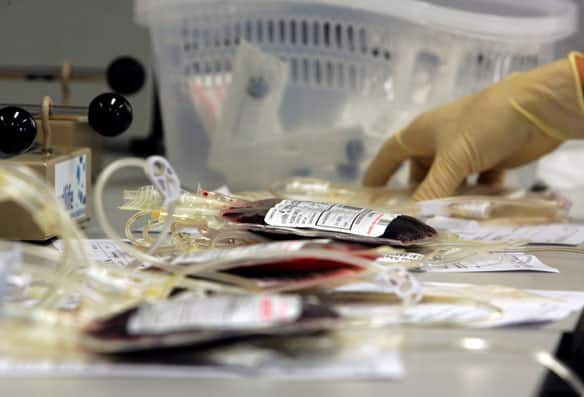The windowless room buzzes with fluorescent light and quiet conversation. Here, inside Edmonton’s central blood donation center, Marissa Chen rolls up her sleeve while the phlebotomist preps her arm with cool antiseptic. It’s her 28th donation, a ritual she began after her father received multiple transfusions during cancer treatment four years ago.
“I never thought about where blood comes from until my dad needed it,” Chen tells me as we sit in the recovery area, where she sips apple juice. “Now I’m here every three months like clockwork.”
What Chen and thousands of other regular Edmonton donors don’t realize is that this vital public health resource has been operating under concerning conditions that health officials have repeatedly flagged but failed to fully address. Internal documents obtained through freedom of information requests reveal a pattern of compliance issues at Edmonton’s main collection facility dating back to 2019.
The problems came to light last month when Alberta Health Services confirmed that inspectors had cited the facility for temperature control irregularities, potentially compromising blood products. According to Dr. Graham Sher, CEO of Canadian Blood Services, these issues have been “identified and remediated,” but former employees paint a more troubling picture.
“We raised concerns about the refrigeration systems for years,” says Leanne Morris, who worked as a collection technician at the facility from 2016 to 2022. “Sometimes you’d come in for morning shift and find temperature logs that showed overnight fluctuations well outside acceptable ranges.”
Health Canada regulations require blood products to be stored at precise temperatures, typically between 1°C and 6°C for whole blood. Even minor deviations can affect protein stability and cellular integrity, potentially reducing transfusion efficacy.
When I visited the site in early spring, the facility appeared clean and organized, with staff efficiently moving donors through the process. Nothing visible suggested the behind-the-scenes issues documented in inspection reports. This disconnect highlights the challenge for donors and recipients alike – the critical infrastructure supporting Canada’s blood supply often operates with minimal public visibility until problems emerge.
The Edmonton situation reflects wider pressures facing Canada’s blood system. A 2022 report from the Canadian Institute for Health Information showed blood product demand increasing by 3.7% annually, while donation rates in major urban centers have plateaued or declined since the pandemic.
“We’re asking more from a system that hasn’t seen the investment it needs,” explains Dr. Lakshmi Krishnan, hematologist at the University of Alberta Hospital. “Infrastructure challenges become inevitable when facilities designed for 1990s collection volumes are trying to meet 2020s demands.”
For Indigenous communities in northern Alberta, these systemic issues compound existing barriers to equitable health services. Samson Cree Nation health director Robert Cardinal describes how blood supply shortages disproportionately impact rural and remote communities.
“When supply is tight, urban centers get priority,” Cardinal explains during our conversation at a community health fair in Maskwacis. “Our members needing transfusions often face delays or must travel significant distances. That’s the reality of healthcare inequity.”
Canadian Blood Services maintains that despite the Edmonton facility’s challenges, the national blood supply remains safe and reliable. They’ve implemented additional monitoring protocols and committed to facility upgrades scheduled for completion by early 2024.
“The safety of recipients is our paramount concern,” says Sylvia Okonofua, Alberta operations director for Canadian Blood Services. “We’ve taken immediate corrective actions and are conducting comprehensive reviews of all storage systems.”
Health Canada’s most recent inspection, conducted in March, found improvements but noted that some temperature control systems still required upgrades. The federal regulator has required monthly compliance reports until all issues are resolved.
For patients depending on blood products, these regulatory processes happen far from view. At the University of Alberta Hospital’s oncology unit, nurse practitioner Devon Williams administers blood components daily to patients fighting cancer and blood disorders.
“Most patients never think about the complex journey blood takes from donor to recipient,” Williams reflects as we watch a ruby-red bag of packed cells drip into a patient’s IV line. “They trust the system to work flawlessly, and most of the time it does.”
That system encompasses a remarkable chain of custody. Once donated, blood undergoes testing, processing, storage, and transportation before reaching hospitals. Each step requires precise documentation and quality control – a system that has historically made Canada’s blood supply among the safest in the world.
The Edmonton facility’s issues highlight the delicate balance between maintaining aging infrastructure and ensuring uninterrupted service. Canadian Blood Services has operated under heightened public scrutiny since its formation in the wake of the tainted blood scandal of the 1980s, when thousands of Canadians contracted HIV and hepatitis C from contaminated blood products.
“That history casts a long shadow,” says health policy researcher Maria Sundaram of the University of Toronto. “It’s why any operational issues, even ones that pose minimal risk like temperature fluctuations, warrant serious attention and transparency.”
Back at the donation center, Chen finishes her juice and prepares to leave. When I mention the facility’s compliance issues, she pauses, visibly processing this new information about a system she’s trusted implicitly.
“I guess I assumed everything was perfect behind the scenes,” she says. “But knowing there are problems doesn’t make me want to stop donating. If anything, it makes me realize how important it is that enough of us keep showing up.”
As Edmonton’s blood bank works to address its challenges, that continued donor commitment remains critical. The system’s resilience depends not just on regulatory oversight and infrastructure investment, but on the thousands of Canadians who regularly extend their arms and give a piece of themselves to strangers they’ll never meet.






